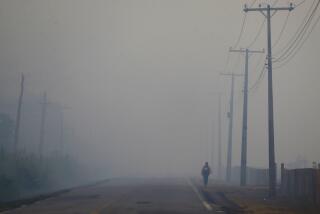Deforestation Seems Worse in Amazon, but Data Kept Secret
- Share via
MARABA, Brazil — In this southeastern corner of the Amazon, the jungle canopy has been supplanted by smoke that hangs so thickly that, at times, it can inflict nosebleeds and force airports to close for days.
The smoke rises from countless fires fed by foliage stripped and then burned to make way for cattle pasture.
In the last two years, the Amazon rain forest has seen some of its worst burning ever. And as the burning season again approaches, environmentalists see little reason why this year should be different.
They argue the fires are part of a little-noticed upswing in Amazon deforestation this decade that followed a much-publicized decline in the late 1980s. Just five years after Brazil hosted the world’s first Earth Summit--amid optimism that conservation was becoming a priority--the Amazon jungle is still going up in smoke.
“The number of fires where there formerly was forest is a good, if indirect, indicator of deforestation,” said Garo Batmanian, president of the World Wildlife Fund in Brazil.
The government says the fires do not necessarily translate into deforestation--many represent farmers maintaining areas previously cut. A government agency has satellite photos that could determine exactly how much forest has been lost. But it seems in no rush to analyze them.
“It would be irresponsible to say whether deforestation is going up or down until the figures are ready,” said Thelma Krug, coordinator for the department with the National Institute of Space Research, which monitors deforestation.
The institute first promised that figures for 1995-96 would be released last November, then in March. It now says they should be ready by October.
The official reason for the delay is a lack of funds to analyze the 229 photos snapped by NASA’s Landsat-5 satellite over the 2 million square miles of the Brazilian Amazon.
The photos remain rolled up, gathering dust.
A visitor to the institute’s Foundation for Science and Space Technology Applications found the poster-sized photos packed in cardboard boxes on the floor.
The foundation has state-of-the-art computers and printers and employs about 30 analysts. But no one has permission to analyze the photos detailing Amazon deforestation until the government releases the $4.5 million promised for the project.
Although that sum is repeatedly handed up as the reason nothing is being done, Krug concedes that analyzing the photos with existing equipment would cost only about $400,000.
Environmentalists claim the government is stonewalling to avoid unpleasant news.
“The only reason that data isn’t analyzed and available is that the government doesn’t want it to be,” said Stephen Schwartzman, a senior scientist at the Environmental Defense Fund in Washington. “The government still deals with it only as a potential international embarrassment and not as something in the interest of the nation.”
By the late 1980s, about one-tenth of the Amazon’s original forest had been cut down. The destruction sparked an international outcry that embarrassed the Brazilian government.
But between 1988 and 1991, a slowdown in the rate of deforestation--due more to an unraveling economy than any coordinated action--allowed the government to claim the trend had been reversed. Much of the furor died down.
In July 1996, the government announced a series of measures to protect the rain forest. They included a moratorium on new concessions to cut mahogany and virola, a source of plywood, and a law forbidding Amazon landowners from cutting more than 20% of their forests--down from 50%.
Almost unnoticed, the government also released figures showing Amazon deforestation had jumped from 4,450 square miles in 1992 to an average of 5,950 square miles in 1993 and 1994--a 34% increase.
Much was made of the new measures, but little was said about the renewed upswing in deforestation. Many people had thought the problem of Amazon destruction had been “solved.”
“The 1992 Rio de Janeiro Earth Summit was the last we heard about the Amazon,” said Philip Fearnside, a scientist at the National Institute for Amazon Research in the jungle city of Manaus.
“The impression people were left with was that deforestation was going down. Then they released the data that showed deforestation had been going up during the four years the government has been claiming that it’s been going down.”
Eduardo Martins, president of Brazil’s Environment Protection Agency, is one of the few high-level government officials willing to admit that Amazon deforestation probably is increasing.
It is the agency’s job to stop the destruction, and the satellite data are crucial. Even with information in hand, it’s a daunting task for the fewer than 400 poorly paid inspectors, who cover a region twice the size of France and Spain combined.
“It doesn’t help to have some general figure--that only adds to our anxiety and fears,” Martins said. “We have to know where it is in order to focus our enforcement. And we have repeatedly insisted that [the National Institute of Space Research] reduce the time in which the information is made available.”
The data are especially important in understanding how Amazon deforestation is changing, he said.
In past decades, deforestation was primarily a result of large-scale projects such as dams, timber harvests, cattle ranches, highways and peasant settlements--often spurred by government incentives.
Today, the forest is being eroded by a host of smaller interests, from furniture makers to poor farmers searching for land.
Another recent threat is an influx of foreign loggers, mainly from Asia, who have been investing heavily in the region since 1994.
A leaked government report recently published in the newspaper O Liberal of Belem, a city at the mouth of the Amazon River, said 80% of Amazon logging is illegal, with many companies extracting 15 to 20 times the amount of lumber legally permitted.
More to Read
Sign up for Essential California
The most important California stories and recommendations in your inbox every morning.
You may occasionally receive promotional content from the Los Angeles Times.










